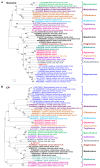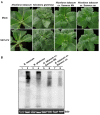Molecular Characterization and Pathogenicity of a Novel Soybean-Infecting Monopartite Geminivirus in China
- PMID: 35215936
- PMCID: PMC8877103
- DOI: 10.3390/v14020341
Molecular Characterization and Pathogenicity of a Novel Soybean-Infecting Monopartite Geminivirus in China
Abstract
Soybean is a major legume crop that plays an important role in food production, industrial production, and animal husbandry. Here, we characterize a novel soybean-infecting monopartite geminivirus identified in China. Analysis of the contigs de novo assembled from sequenced small interfering RNAs, followed by PCR, cloning, and sequencing, the complete viral genome was determined to be 2782 nucleotides. The genome contains the conserved nonanucleotide sequence, TAATATTAC and other sequence features typical of the family Geminiviridae, and encodes two and four open reading frames in the virion-sense and the complementary-sense strands, respectively. Genome-wide pairwise identity analysis revealed that the novel virus shares less than 65.6% identity with previously characterized geminiviruses. Phylogenetic and recombination analysis indicated that this virus was placed in a unique taxon within the family Geminiviridae and potentially arose from recombination. An infectious clone of this virus was further constructed and its infectivity was tested in different species of plants. Successful infection and characteristic symptoms were observed in Glycine max, Nicotiana benthamiana, N. tabacum, N. glutinosa, and N. tabacum cv. Samsun plants. Taken together, this virus represents a member of an unclassified genus of the family Geminiviridae, for which the name soybean yellow leaf curl virus is proposed.
Keywords: geminivirus; recombination; soybean; ssDNA virus.
Conflict of interest statement
The authors declare no conflict of interest. The funding sponsors had no role in the design of the study; in the collection, analyses, or interpretation of data; in the writing of the manuscript, orin the decision to publish the results.
Figures






Similar articles
-
Molecular characterization and pathogenicity of a novel monopartite geminivirus infecting tobacco in China.Virology. 2024 Jun;594:110061. doi: 10.1016/j.virol.2024.110061. Epub 2024 Mar 15. Virology. 2024. PMID: 38518441
-
Tomato yellow leaf curl China virus: monopartite genome organization and agroinfection of plants.Virus Res. 2001 Dec 4;81(1-2):69-76. doi: 10.1016/s0168-1702(01)00363-x. Virus Res. 2001. PMID: 11682126
-
Isolation and characterization of a novel geminivirus from parsley.Virus Res. 2020 Sep;286:198056. doi: 10.1016/j.virusres.2020.198056. Epub 2020 Jun 25. Virus Res. 2020. PMID: 32593914
-
Soybean stay-green associated geminivirus: A serious threat to soybean production in China.Virology. 2025 Jan;602:110312. doi: 10.1016/j.virol.2024.110312. Epub 2024 Nov 21. Virology. 2025. PMID: 39586207 Review.
-
Geminiviruses and Plant Hosts: A Closer Examination of the Molecular Arms Race.Viruses. 2017 Sep 15;9(9):256. doi: 10.3390/v9090256. Viruses. 2017. PMID: 28914771 Free PMC article. Review.
Cited by
-
Whole-plant microbiome profiling reveals a novel geminivirus associated with soybean stay-green disease.Plant Biotechnol J. 2022 Nov;20(11):2159-2173. doi: 10.1111/pbi.13896. Epub 2022 Aug 27. Plant Biotechnol J. 2022. PMID: 35869670 Free PMC article.
-
The rising threat of geminiviruses: molecular insights into the disease mechanism and mitigation strategies.Mol Biol Rep. 2023 Apr;50(4):3835-3848. doi: 10.1007/s11033-023-08266-y. Epub 2023 Jan 26. Mol Biol Rep. 2023. PMID: 36701042 Review.
-
Molecular characterization to study the genetic diversity of begomoviruses occurring in the major chilli growing areas of Tamil Nadu state of India.Int Microbiol. 2025 Apr;28(4):863-876. doi: 10.1007/s10123-024-00580-0. Epub 2024 Sep 4. Int Microbiol. 2025. PMID: 39230779
-
Evaluation of soybean germplasms for resistance to stay-green syndrome.Sci Rep. 2025 Mar 10;15(1):8164. doi: 10.1038/s41598-024-83227-4. Sci Rep. 2025. PMID: 40059115 Free PMC article.
-
Elucidating the ecophysiology of soybean pod-sucking stinkbug Riptortus pedestris (Hemiptera: Alydidae) based on de novo genome assembly and transcriptome analysis.BMC Genomics. 2024 Apr 2;25(1):327. doi: 10.1186/s12864-024-10232-2. BMC Genomics. 2024. PMID: 38565997 Free PMC article.
References
Publication types
MeSH terms
LinkOut - more resources
Full Text Sources
Other Literature Sources

